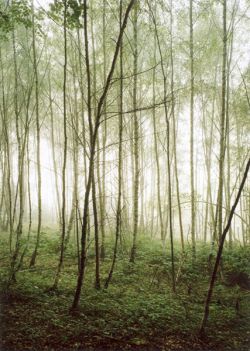 “The clearest way into the Universe is through a forest wilderness,” wrote John Muir (in a posthumous collection of his notes called John of the Mountains).
“The clearest way into the Universe is through a forest wilderness,” wrote John Muir (in a posthumous collection of his notes called John of the Mountains).
Yes, but why? Why does a wild forest take us into the universe more surely than the open sea? Or a vast metropolis teeming with people?
This month in Orion, critic and novelist John Berger takes a crack at that question in an essay called “Between Forests” (not online, unfortunately). Berger takes the forest photographs of Czech photographer Jitka Hanzlová as a point of departure. A glance at one of Hanzlová’s mysterious photographs from her Forest series gets across Berger’s essential point — they have been taken “from the inside” of the forest. He writes:
A forest is what exists between its dense undergrowth and its clearings, between all its life cycles and their different time-scales, ranging from solar energy to insects that live for a day … Throughout history and prehistory forests have offered shelter, a hiding place, while also being places in which a wanderer can be ultimately lost. They oblige us to recognize how much is hidden.
He goes on to argue that this sense of peering into the hidden explains Hanzlová’s saying that “the way I go is the way back to see the future.” These are not photographs that stop time, in other words; these are photographs that take us “somewhere between the past, present, and future.”
Berger adds:
To make sense of what I am suggesting, it is necessary to reject the notion of time that began in Europe during the eighteenth century and that is closely linked with the positivism and linear accountability of modern capitalism: the notion that a single time, which is unilinear, regular, abstract, and irreversible, carries everything. All other cultures have proposed a coexistence of various times surround in someway by the timeless.
Could these mysterious photographs be reaching us emotionally because we sense the end of this modern conception of time? In another extraordinary essay, published earlier this year in Poetry by Tony Hoagland, the essayist quotes the poet Carolyn Forché as saying, in essence, yes:
Our age lacks the structure of a story. Or perhaps it would be closer to say that narrative implies progress and completion. The history of our time does not allow for any of the bromides of progress, nor for the promise of a successful closure.
Could this be why so many poets these days, including Forché, reject narrative poetry for the associative? Could it be why so many important movies these days (from Pulp Fiction to Traffic) abandon the linear narrative? Could this be why so many television series (from Big Love to Grey’s Anatomy) thrive on multiple plotlines? Could this be why our novelists increasingly write books impossible to condense to a single narrative? (Take Thomas Pynchon’s new Against The Day, which novelist Gilberto Sorrentino calls “three or four books in one” in a review for the LA Times … and which he says leads, like a snake eating its tail, up to Pynchon’s all-encompassing earlier masterpiece, Gravity’s Rainbow.)
It’s impossible to prove a societal perception, of course, but let me ask:
Sorry, the poll you are seeking no longer exists. If you’re in a voting mood, suggest a poll and you might just see it on the site.


